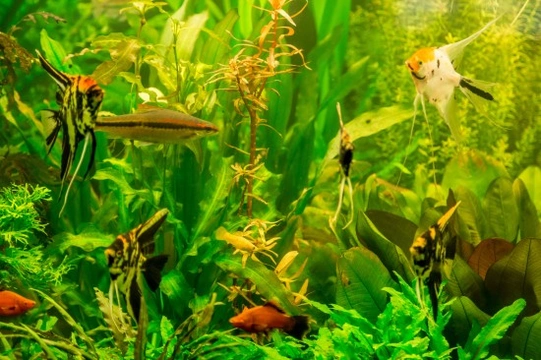
Identifying problems and illnesses in your fish tank
It is important to get to know the normal appearance, health and behaviour of the fish within your tank, in order to be able to spot potential problems if they arise too. Getting to grips with any problems early on and correcting any imbalances within the tank is the key to keeping your fish healthy, and much easier than trying to sort out a serious problem later on down the line!
However, not every apparently odd or abnormal fish behaviour is the sign of a problem- fish’s natural behaviours may change at times for other reasons too, such as if they are spawning or preparing to breed, or if you add new fish to the tank, while the original tank inhabitants settle down.
In this article, we will look at the basics of spotting and identifying problems and anomalies within your fish tank, and in your fish themselves. Read on to learn more!
Unusual swimming patterns
Watching your fish swimming and noticing that they are moving oddly through the water can be one of the very first signs that something in the tank is not quite right. If your fish seems to be just drifting around the tank rather than actively swimming, can only swim in circles, or are swimming upside down or out of balance, these may all be signs that something is wrong with either that specific fish, or the tank as a whole.
The gills and drawing breath
Fish open and close their mouths regularly as part of their natural cycling of the water, but if your fish’s gills are looking off colour, are protruding or appear to be sticking out or moving in a laboured manner, this requires further investigation.
Gasping for air may be indicative of low oxygen levels within the tank, meaning that you need to increase the tank aeration, or can be due to poor water quality and a range of other factors too. Once you have corrected the imbalance, the issue should then resolve itself; if the problem remains, it is possibly a symptom of illness or disease.
Across all of the different types and species of fish, there is no one uniform respiration rate or breathing pattern that is deemed to be correct, so when you know that your fish are healthy, take the time to observe their normal respiration patterns in order to better spot if something changes in your fish’s behaviour later.
Also, keep an eye on the colour of your fish’s gills; if they discolour and appear pale, this is yet another indication of poor health or tank problems.
Weight loss and anorexia
If your fish are reluctant to eat, appear to be having problems eating or are losing weight for no obvious reason, these are all warning signs that you should not ignore.
Constipation is a common problem in aquarium fish, and constipation can lead to a loss of appetite and condition too, while also causing a swelling to the abdomen that may ultimately prove to be fatal.
Refusal to eat or appearing to have problems eating normally can be harder to identify, but is often caused by either feeding an inappropriate diet to your fish, or by allowing the water quality and filtration to become so poor that it is not fit to support life. Be aware that some species of fish will stop eating when they are spawning or carrying eggs, so look for this as a possible explanation too if your tank parameters are within normal ranges.
Sores and marks on the skin
Fish are prone to a great many different types of skin conditions and problems, including parasite infestations, fungus, slime, sores and rough patches. Some conditions such as Ich can lead to irritation of the scales, causing your fish to scratch themselves on the tank furniture to the point that they do themselves an injury and invite infection.
Never ignore growths, marks or changes on your fish’s skin, as these may indicate a parasite infection within the tank, or a disease going around.
Your fish’s colour
Fish will often change colours as they age, and some juvenile fish look quite different to their fully grown adult counterparts! Learn about the colours and patterns that your fish will naturally display at different ages, so that you can spot a potential problem from the natural aging of your fish.
Fish that are feeling generally unwell will often lose their colour and become paler and less vivid, something that can be caused by a whole myriad of reasons that you may have problems getting to the bottom of. Also, bear in mind that changes in food can also affect your fish’s colours, so if you have recently made dietary changes to the food that goes into the tank, consider this as well.



